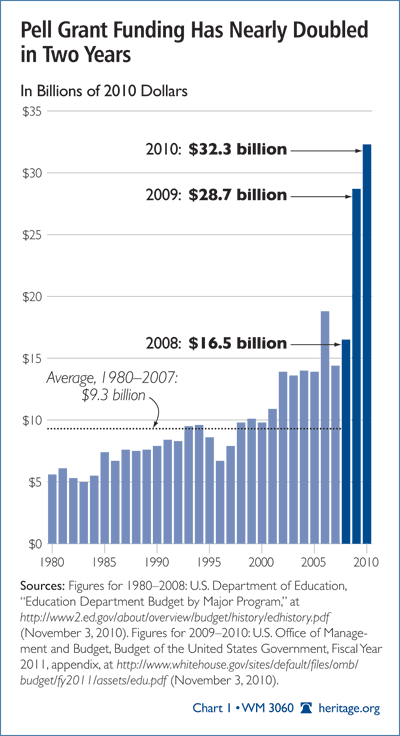During the 2010–2011 school year, 8.3 million college students received an average of $3,865 in Pell grant funding at a cost of more than $32 billion, the maximum award being $4,860.[1]
The Obama Administration and some Members of Congress argue that another $5.7 billion is needed in order to avoid a funding shortfall and a reduction in the maximum grant award of 15 percent. But continuing to increase federal subsidies for higher education through the Pell grant program would not solve the college cost problem and could exacerbate inefficiencies and tuition hikes at universities.
College Costs Rise as Federal Subsidies Increase
Pell grants, which do not have to be repaid by students, are currently funded at historically high levels. Funded at $32 billion for the 2010–2011 school year, the program includes $15.6 billion in new appropriations provided through the American Recovery and Reinvestment Act of 2009. Moreover, new student loan legislation passed as part of the Patient Protection and Affordable Care Act of 2010 included $13.5 billion in mandatory Pell funding through 2012.
New funding for the Pell program is part of a long history of increases in federal subsidies for higher education. Pell grant funding has nearly doubled in the past two years, and since 1980, Pell grant funding has increased 475 percent, after adjusting for inflation.

The Obama Administration would like to continue building on decades of increases in Pell funding in the coming years. The President’s FY 2011 Budget request calls for mandatory outlays for federal Pell grants to exceed $51 billion by the year 2020.
Meanwhile, college tuition has risen significantly. Since 1982, the cost of attending college has increased 439 percent, more than four times the rate of inflation. Increases in college costs exceed increases in health care costs, which have risen more than 250 percent over the same time period.[2]
Federal funding is contributing to this exorbitant increase in college costs. Economist Richard Vedder argues that “some of these financial aid programs have contributed mightily to the explosion in tuition and fees in modern times.”[3] Moreover, Vedder notes:
When someone else is paying the bills, people want to buy more of the good or service in question at prevailing prices than when the customer pays the bills. This means a higher demand for higher education, and other things being equal, higher tuition costs. … Each one dollar in grant aid leads to tuition fees somewhere around 35 cents higher than would otherwise be the case. Just as third-party payments in medicine have led to escalating health care costs, so increased student financial payments have contributed to soaring tuition costs.[4]
Overlooking the relationship between increased federal subsidies and rising college costs, proponents of increased Pell funding want to continue down this path. The Obama Administration and certain Members of Congress say an increase in Pell funding is necessary to ensure more students have access to college. Senator Tom Harkin (D–IA) recently stated, “This decrease [in Pell funding] would hit at a time when many Americans are returning to school in an effort to make themselves more competitive for jobs in these tough economic times.”[5]
More Federal Funding Is Not the Answer
Over the past few decades, a vicious cycle has been perpetuated by federal education policy: The Department of Education increases subsidies for college, inflating students’ purchasing power, in turn allowing universities to raise tuition, which ultimately increases the demand for more government subsidies.
Not only would an increase in Pell funding not break this vicious cycle, but it would also fail to place pressure on universities to use resources more efficiently. Andrew Gillen, an expert in higher education financing, has dubbed the dysfunctional higher education market an “arms race” where vast resources are targeted toward non-academic purposes such as athletics, building renovations, and administrative overhead costs in order to compete for students.[6]
Perhaps most troublesome of all, continuing to increase federal subsidies for college raises questions of equity. Increasing federal subsidies for higher education—whether in the form of Pell grants or student loans—shifts the responsibility of paying for college from the student, who directly benefits from college, to the taxpayer. Transferring the burden of student loan financing from university graduates—who earn on average twice that of someone with a high school diploma—to the three-quarters of taxpayers who did not attend college is unjust.[7]
Congress should restructure the Pell grant program so that funding goes directly to students, not to universities, and should limit access to Pell grants after four years of undergraduate work.[8]
A Better Plan for Reducing College Costs
The Obama Administration has set a goal of the United States having the highest percentage of college graduates by 2020. Instead of continuing to increase federal subsidies for college—a plan unlikely to increase the percentage of students attending college—the Administration and Congress should consider reforms that would lower costs over the long term.
Lindsey M. Burke is an Education Policy Analyst in Domestic Policy Studies at The Heritage Foundation. Brian Riedl, the Grover Hermann Fellow in Federal Budgetary Affairs in the Thomas A. Roe Institute for Economic Policy Studies at The Heritage Foundation, contributed to this report.



